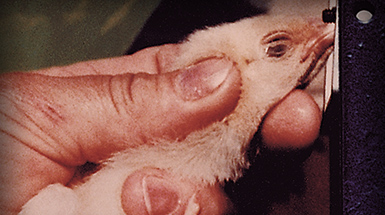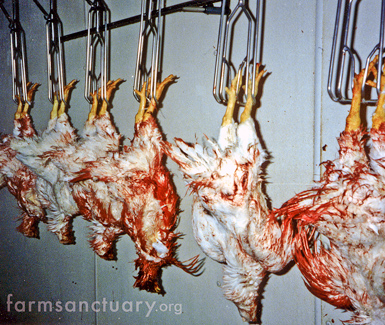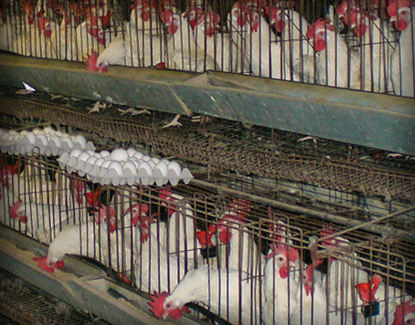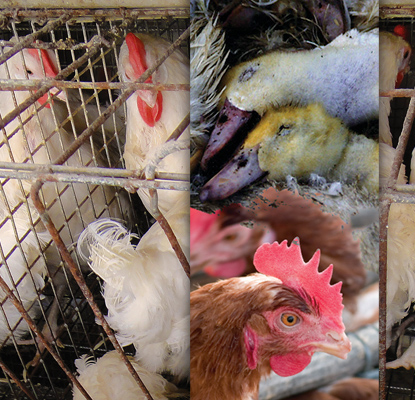|
Animal cruelty defines each part of production, from birth to slaughter.
► EGG LAYING HENS: USDA recommends 4 hens per each 16-inch wide cage. Egg producers typically pack 6 to 9 hens in wire coops no larger than a filing drawer. Each bird occupies a space half the size of a sheet of paper. 98% of egg-laying hens live in battery cages stacked inside dark sheds (College of Agriculture and Biological Sciences, South Dakota State University).
► DEBEAKING: To reduce stress-related fighting and cannibalism, workers amputate the bottom third of each bird's beak without anesthesia. Mechanized blades slice through bone, cartilage and soft tissue. Post-mutilation birds peck obsessively, suggesting chronic phantom limb pain in the tender amputated beak. Mangled beaks may grow infected or too painful for birds to eat.

► FORCED MOLTING: Hens are starved in 10-14 day cycles to boost egg output. “Over 3/4 of Salmonella Enteritidis outbreaks were linked to eggs…with causes cited in the report as…forced molting” (Centers for Disease Control and Prevention). Starved birds suffer broken bones and severe stress. Suppressed immune systems predispose hens and eggs to Salmonella infection. Hens who survive molts often choke to death if food is restored. “Most parts of their skin are bare with no feathers” (Applied Animal Behaviour Science, Vol 25:97-105).
► MASHING OF MALE CHICKS: The egg industry, in its quest to automate production, has used industrial-strength garbage disposals to mash unwanted chicks. “Even after 20 seconds, there were only partly damaged animals with whole skulls,” eyewitness research scientist. Each year, 280 million or more male chicks, who don't lay eggs and aren’t a profitable meat source, are tossed into garbage tubs or plastic bags to be crushed alive, some used as fertilizer. Others are dumped into augers that grind baby birds. Mutilated chicks are dumped onto neighboring fields with manure spreaders. One eyewitness writes: “A horrible peeping came from the pile.”
► BIRDS MANUFACTURED FOR MEAT: Turkeys and chickens spend brief lives in “grower houses” without room to flutter a wing or extend a leg. They cannot build nests, dust bathe, perch, scratch the ground, or express any natural traits. Disease, smothering and heart attacks are common. Millions die from heat exhaustion, freezing or transport accidents. From birth to death, each bird occupies a half square foot of feces and urine-soaked space.
► FRANKENBIRDS: White turkeys are a synthetic invention. They barely resemble colorful wild relatives who soar 55 miles per hour and live 15 years. Forced to grow twice as fast and large, anatomically altered birds cannot bear their weight. An industry journal says they “have problems standing and fall and are trampled on or seek refuge under feeders, leading to bruises and downgradings as well as culled or killed birds.” Genetically engineered turkeys can't reproduce on their own. Males are milked for their semen. Hens are tossed down dark, slick chutes into breeding rooms. Workers force open their vents to artificially inseminate them. Some drop dead from heart attacks.
Chickens are genetically bred to grow so large, their legs cannot bear their weight. Before slaughter weight at 6-weeks, many crippled birds starve to death within inches of food. Each year, more than 50 billion chickens are eaten worldwide. The industry boasts 41 days to “grow a broiler to slaughter weight (2kg) with a stated goal to reduce this period by 1 day a year,” (International Health News Database). Bird systems are “biased towards economics of production and detrimental to welfare” (Toby Knowles, Bristol University Division of Food Animal Science; Study Raises Issue With Broiler Chicken Welfare, Food Production Daily). Research suggests birds are in pain, [with] growth rate as a primary factor behind leg disease. “In the past 50 years broiler growth rates have increased by over 300% from 25g per day to 100g per day,” says researcher Knowles, citing intensive genetic selection.
► TRANSPORT: Jammed in crates atop truckbeds, birds endure weather extremes before forklifts dump them on conveyer belts. Fallen birds are ignored and often crushed by machinery or vehicles near unloading docks. Others die on the ground from starvation or exposure.

► SLAUGHTER: Chickens and turkeys comprise 90% of animals used for U.S. food, yet are omitted from the Humane Slaughter Act. The poultry kill floor is mostly staffed by immigrant laborers. They suffer stress, repetitive strain injuries and limb wounds that far exceed the national median. On the breakneck production line, shackled birds hang upside down from revolving rails. Their heads are plunged into electrified baths. Merely paralyzed, conscious birds proceed to mechanized throat-slashers. The blades are notoriously imprecise. Dazed animals fall from racks and wander over blood-wet floors. Some birds are still alert when pitched into scalding water for feather extraction. Workers call the boiled-alive birds “redskins” Over 50 billion chickens are killed worldwide each year.
|

Health food? Flesh and eggs come from sick, drugged birds.
► CHOLESTEROL AND FAT: 3.5 oz. serving of beef and 3.5 oz. serving of white chicken meat = same amount cholesterol: 85 mgs. Light, skinless chicken derives about 18% of calories from fat. Skinless roast dark meat chicken is 32% fat (J & M McDougall, The McDougall Plan, Piscataway NJ: New Century, 322-328). Cholesterol is mainly in lean portions of meat. Saturated fats that permeate these portions raise cholesterol by stimulating the liver to make more cholesterol. Thus, even “lean” meats have significant amounts of saturated fat in addition to cholesterol (N D Barnard, MD, The Power of Your Plate, Summertown TN: Book Publishing Co, 20). Turkey and chicken have no fiber or carbohydrates. A turkey leg, with 72 mgs. cholesterol and 47% saturated fat, boasts more “bad stuff” than many beef cuts (Physician's Committee for Responsible Medicine, Chicken Is Not a Health Food).
► AVIAN INFLUENZA: Avian influenza [bird flu] is a contagious disease of poultry caused by viruses that infect farm-raised and wild birds. Two main types: low pathogenic (LPAI) and highly pathogenic (HPAI). LPAI causes mild symptoms (ruffled feathers, respiratory signs, drop in egg production) and may go undetected. HPAI is more virulent, spreading rapidly through flocks and killing most birds in 48 hours.
Nations with industrialized livestock are susceptible to the lethal strain of avian flu. “In intensively farmed poultry, the high density of birds and constant exposure to feces, saliva and other secretions provide ideal conditions for the replication, mutation, recombination and selection through which highly lethal forms can evolve. [With] the global nature of the poultry industry… we have the most plausible mechanism for spread of the virus,” (Dr. Leon Bennun, Director of Science, Policy and Information for Birdlife International, 2006). Deadly Avian Influenza began in Southeast Asia and progressed into southern Asia, Europe and Africa. Veterinary experts with U.S. poultry companies view smuggled gamecock as a hot button to ignite a bird flu epidemic here (Regions Affected with Highly Pathogenic Avian Influenza subtype H5N1, www.aphis.usda.gov/vs/ncie/country.html#HPAI, U.S. Department of Agriculture).

► ARSENIC: A study by Dr. Partha Basu, Duquesne University Dept. of Chemistry and Biochemistry, links human disease to the antibiotic arsenic compound roxarsone, a feed additive for pinker, bigger-breasted birds. The U.S. uses 2.2 million pounds of roxarsone yearly (in chicken, turkey and pig feed). Lab analysis shows roxarsone, which promotes blood vessel growth in chickens, does the same in human cell lines — a key first step in cancer and many diseases. Chronic exposure to inorganic arsenic is also linked to heart disease, diabetes, brain function decline ( Chicken Feed Additive May Pose Danger, thepoultrysite.com; Environmental Health Perspectives, Journal of Nat'l Institute of Environmental Health Sciences).
► ANTIBIOTIC RESISTANCE: Waste from industrial chicken houses is rich in genes called integrons that promote spread and persistence of clusters of varied antibiotic resistance genes…a growing problem for farm animal operations and human health ( Proceedings of National Academy of Sciences, 4/19/04). Some 29 million pounds of antibiotics — about 80% of total U.S. antibiotic usage — are annually mixed into feed to spur livestock growth ( National Resource Defense Council/Union of Concerned Scientists). Antibiotic use in agriculture is opposed because it fosters [new strains] of cure-resistant bacteria ( American Medical Assoc. and World Health Organization).
► SICK ANIMALS = SICK FOOD: In tests on 525 chickens from supermarkets, gourmet shops and natural food stores in 23 states, 83% of chickens harbored Campylobacter and Salmonella food poisoning bacteria. 84% of Salmonella and 67% of Campylobacter bacteria analyzed showed resistance to antibiotics. Consumer Reports calls its findings “largest national analysis of contamination and antibiotic resistance in store-bought chicken ever published,” ( Jan. 2007 Consumer Reports; Bacteria Exposed in Jan. 2007 Consumer Reports' “Dirty Chickens,” Winter 2007 UPC Poultry Press).
A 2002 listeriosis outbreak that killed 20 people and sickened 120 more caused a 27.4 million-lb. poultry recall ( Institute for Agriculture-Trade Policy, “The Cost of Cheap Food” IATP. 2003).
► HORMONES: “If a 7 pound baby grew at the rate that today's turkey grows, when the baby reached 18 weeks old, it would weigh 1,500 pounds,” ( Lancaster Farming).
U.S. Annual Livestock Slaughter Statistics
|

